Ceftriaxone-Loaded Liposomal Nanoparticles for Pulmonary Delivery Against Lower Respiratory Tract Infections: Development and Characterization
Abstract
1. Introduction
2. Results and Discussion
2.1. Preparation and Rationale of Liposomal NPs
2.2. CTX Analysis by Reversed-Phase High-Performance Liquid Chromatography (RP-HPLC) and Method Optimization
2.3. Particle Size, Polydispersity Index (PDI), and Zeta Potential Evaluation
2.4. Morphology Evaluation
2.5. Drug Entrapment and Drug Loading Determination
2.6. Attenuated Total Reflection-Fourier Transform Infrared (ATR-FTIR)
2.7. Differential Scanning Calorimetry and Thermogravimetric Analysis
2.8. Powder X-Ray Diffraction (PXRD) Analysis
Crystal Configuration of API Component Phases
2.9. In Vitro Drug Release Study
2.10. Kinetics of Drug Release
2.11. Powder Density and Flow Property Evaluation
2.12. Aerosolization Performance of the Formulations
3. Materials and Methods
3.1. Materials
3.2. Preparation of CTX-Incorporated Liposomal NPs
3.3. Analysis of CTX by RP-HPLC and Method Optimization
3.4. Characterization of Prepared Formulations
3.4.1. Particle Size, Polydispersity Index, and Zeta Potential Evaluation
3.4.2. Morphological Evaluation
3.4.3. Drug Loading and Drug Entrapment Evaluation
3.4.4. ATR-FTIR Evaluation
3.4.5. DSC and TGA Analysis
3.4.6. PXRD Evaluation
3.4.7. In Vitro CTX Release Evaluation
3.4.8. Kinetics of CTX Release from Liposomal NPs
3.4.9. Particle Density and Flow Property Evaluation
3.4.10. In Vitro Aerosolization Study
3.5. Statistical Analyses
4. Conclusions
Supplementary Materials
Author Contributions
Funding
Institutional Review Board Statement
Informed Consent Statement
Data Availability Statement
Acknowledgments
Conflicts of Interest
References
- Sabuj, M.Z.R.; Dargaville, T.R.; Nissen, L.; Islam, N. Inhaled ciprofloxacin-loaded poly(2-ethyl-2-oxazoline) nanoparticles from dry powder inhaler formulation for the potential treatment of lower respiratory tract infections. PLoS ONE 2021, 16, e0261720. [Google Scholar] [CrossRef] [PubMed]
- Panthi, V.K.; Fairfull-Smith, K.E.; Islam, N. Ciprofloxacin-Loaded Inhalable Formulations against Lower Respiratory Tract Infections: Challenges, Recent Advances, and Future Perspectives. Pharmaceutics 2024, 16, 648. [Google Scholar] [CrossRef] [PubMed]
- Jennings, L.K.; Dreifus, J.E.; Reichhardt, C.; Storek, K.M.; Secor, P.R.; Wozniak, D.J.; Hisert, K.B.; Parsek, M.R. Pseudomonas aeruginosa aggregates in cystic fibrosis sputum produce exopolysaccharides that likely impede current therapies. Cell Rep. 2021, 34, 108782. [Google Scholar] [CrossRef]
- Baryakova, T.H.; Pogostin, B.H.; Langer, R.; McHugh, K.J. Overcoming barriers to patient adherence: The case for developing innovative drug delivery systems. Nat. Rev. Drug Discov. 2023, 22, 387–409. [Google Scholar] [CrossRef]
- He, S.; Gui, J.; Xiong, K.; Chen, M.; Gao, H.; Fu, Y. A roadmap to pulmonary delivery strategies for the treatment of infectious lung diseases. J. Nanobiotechnol. 2022, 20, 101. [Google Scholar] [CrossRef]
- Weers, J. Inhaled antimicrobial therapy—Barriers to effective treatment. Adv. Drug Deliv. Rev. 2015, 85, 24–43. [Google Scholar] [CrossRef]
- Maselli, D.J.; Keyt, H.; Restrepo, M.I. Inhaled Antibiotic Therapy in Chronic Respiratory Diseases. Int. J. Mol. Sci. 2017, 18, 1062. [Google Scholar] [CrossRef]
- Donnelley, M.; Parsons, D.W. Gene therapy for cystic fibrosis lung disease: Overcoming the barriers to translation to the clinic. Front. Pharmacol. 2018, 9, 1381. [Google Scholar] [CrossRef]
- Li, J.; Zhang, K.; Wu, D.; Ren, L.; Chu, X.; Qin, C.; Han, X.; Hang, T.; Xu, Y.; Yang, L.; et al. Liposomal remdesivir inhalation solution for targeted lung delivery as a novel therapeutic approach for COVID-19. Asian J. Pharm. Sci. 2021, 16, 772–783. [Google Scholar] [CrossRef]
- Bilton, D.; Pressler, T.; Fajac, I.; Clancy, J.P.; Sands, D.; Minic, P.; Cipolli, M.; Galeva, I.; Solé, A.; Quittner, A.L. Amikacin liposome inhalation suspension for chronic Pseudomonas aeruginosa infection in cystic fibrosis. J. Cyst. Fibros. 2020, 19, 284–291. [Google Scholar] [CrossRef]
- Panthi, V.K.; Fairfull-Smith, K.E.; Islam, N. Antibiotic loaded inhalable liposomal nanoparticles against lower respiratory tract infections: Challenges, recent advances, and future perspectives. J. Drug Deliv. Sci. Technol. 2024, 94, 105517. [Google Scholar] [CrossRef]
- Panthi, V.K.; Bashyal, S.; Paudel, K.R. Docetaxel-loaded nanoformulations delivery for breast cancer management: Challenges, recent advances, and future perspectives. J. Drug Deliv. Sci. Technol. 2024, 92, 105314. [Google Scholar] [CrossRef]
- Vyas, S.P.; Khatri, K. Liposome-based drug delivery to alveolar macrophages. Expert Opin. Drug Deliv. 2007, 4, 95–99. [Google Scholar] [CrossRef] [PubMed]
- Moskowitz, S.M.; Foster, J.M.; Emerson, J.; Burns, J.L. Clinically feasible biofilm susceptibility assay for isolates of Pseudomonas aeruginosa from patients with cystic fibrosis. J. Clin. Microbiol. 2004, 42, 1915–1922. [Google Scholar] [CrossRef]
- Bruinenberg, P.; Blanchard, J.D.; Cipolla, D.C.; Dayton, F.; Mudumba, S.; Gonda, I. Inhaled liposomal ciprofloxacin: Once a day management of respiratory infections. In Respiratory Drug Delivery; Davis Healthcare International Publishing River Grove: Orlando, FL, USA, 2010. [Google Scholar]
- Panthi, V.K.; Fairfull-Smith, K.E.; Islam, N. Liposomal drug delivery strategies to eradicate bacterial biofilms: Challenges, recent advances, and future perspectives. Int. J. Pharm. 2024, 655, 124046. [Google Scholar] [CrossRef]
- Ferguson, L.T.; Ma, X.; Myerson, J.W.; Wu, J.; Glassman, P.M.; Zamora, M.E.; Hood, E.D.; Zaleski, M.; Shen, M.; Essien, E.O.; et al. Mechanisms by Which Liposomes Improve Inhaled Drug Delivery for Alveolar Diseases. Adv. NanoBiomed Res. 2023, 3, 2200106. [Google Scholar] [CrossRef]
- Valiulin, S.V.; Onischuk, A.A.; Baklanov, A.M.; An’kov, S.V.; Dubtsov, S.N.; Alekseev, A.A.; Shkil, N.N.; Nefedova, E.V.; Plokhotnichenko, M.E.; Tolstikova, T.G.; et al. Aerosol Inhalation Delivery of Ceftriaxone in Mice: Generation Procedure, Pharmacokinetics, and Therapeutic Outcome. Antibiotics 2022, 11, 1305. [Google Scholar] [CrossRef]
- Bassetti, M.; Vena, A.; Russo, A.; Peghin, M. Inhaled Liposomal Antimicrobial Delivery in Lung Infections. Drugs 2020, 80, 1309–1318. [Google Scholar] [CrossRef]
- Ebrahimi, S.; Farhadian, N.; Karimi, M.; Ebrahimi, M. Enhanced bactericidal effect of ceftriaxone drug encapsulated in nanostructured lipid carrier against gram-negative Escherichia coli bacteria: Drug formulation, optimization, and cell culture study. Antimicrob. Resist. Infect. Control 2020, 9, 28. [Google Scholar] [CrossRef]
- Rodvold, K.A.; George, J.M.; Yoo, L. Penetration of anti-infective agents into pulmonary epithelial lining fluid: Focus on antibacterial agents. Clin. Pharmacokinet. 2011, 50, 637–664. [Google Scholar]
- Yu, J.Y.; Chuesiang, P.; Shin, G.H.; Park, H.J. Post-Processing Techniques for the Improvement of Liposome Stability. Pharmaceutics 2021, 13, 1023. [Google Scholar] [CrossRef] [PubMed]
- Matharoo, N.; Mohd, H.; Michniak-Kohn, B. Transferosomes as a transdermal drug delivery system: Dermal kinetics and recent developments. WIREs Nanomed. Nanobiotechnol. 2024, 16, e1918. [Google Scholar] [CrossRef] [PubMed]
- Nsairat, H.; Khater, D.; Sayed, U.; Odeh, F.; Al Bawab, A.; Alshaer, W. Liposomes: Structure, composition, types, and clinical applications. Heliyon 2022, 8, e09394. [Google Scholar] [CrossRef] [PubMed]
- Nepal, U.; Panthi, V.K.; Chaudhary, N.P.; Chaudhary, S. A Validated RP-HPLC Method for Simultaneous Determination of Cefixime and Clavulanic Acid Powder in Pediatric Oral Suspension. Int. J. Anal. Chem. 2022, 2022, 8331762. [Google Scholar] [CrossRef]
- Panthi, V.K.; Nepal, U. Formulation and Development of a Water-in-Oil Emulsion-Based Luliconazole Cream: In Vitro Characterization and Analytical Method Validation by RP-HPLC. Int. J. Anal. Chem. 2022, 2022, 7273840. [Google Scholar] [CrossRef]
- Nugraheni, R.; Mulyadi, N.; Yusuf, H. Freeze-Dried Liposome Formulation for Small Molecules, Nucleic Acid, and Protein Delivery. Syst. Rev. Pharm. 2020, 11, 143–151. [Google Scholar]
- Wieber, A.; Selzer, T.; Kreuter, J. Physico-chemical characterisation of cationic DOTAP liposomes as drug delivery system for a hydrophilic decapeptide before and after freeze-drying. Eur. J. Pharm. Biopharm. 2012, 80, 358–367. [Google Scholar] [CrossRef]
- Grüne, L.; Bunjes, H. Solubility of Poorly Soluble Drugs in Phosphatidylcholine-Based Drug Delivery Systems: Comparison of the Loading Capacity in the Bulk Formulation and Its Dispersed State. Pharmaceuticals 2024, 17, 400. [Google Scholar] [CrossRef]
- Owodeha-Ashaka, K.; Ilomuanya, M.O.; Iyire, A. Evaluation of sonication on stability-indicating properties of optimized pilocarpine hydrochloride-loaded niosomes in ocular drug delivery. Prog. Biomater. 2021, 10, 207–220. [Google Scholar] [CrossRef]
- Khan, I.; Needham, R.; Yousaf, S.; Houacine, C.; Islam, Y.; Bnyan, R.; Sadozai, S.K.; Elrayess, M.A.; Elhissi, A. Impact of phospholipids, surfactants and cholesterol selection on the performance of transfersomes vesicles using medical nebulizers for pulmonary drug delivery. J. Drug Deliv. Sci. Technol. 2021, 66, 102822. [Google Scholar] [CrossRef]
- Witayaudom, P.; Klinkesorn, U. Effect of surfactant concentration and solidification temperature on the characteristics and stability of nanostructured lipid carrier (NLC) prepared from rambutan (Nephelium lappaceum L.) kernel fat. J. Colloid Interface Sci. 2017, 505, 1082–1092. [Google Scholar] [CrossRef] [PubMed]
- Ibrahim, N.; Raman, I.; Yusop, M.R. Effects of functional group of non-ionic surfactants on the stability of emulsion. Malays. J. Anal. Sci. 2015, 19, 261–267. [Google Scholar]
- Klinkesorn, U.; Namatsila, Y. Influence of chitosan and NaCl on physicochemical properties of low-acid tuna oil-in-water emulsions stabilized by non-ionic surfactant. Food Hydrocoll. 2009, 23, 1374–1380. [Google Scholar] [CrossRef]
- de Morais, J.M.; dos Santos, O.D.H.; Delicato, T.; da Rocha-Filho, P.A. Characterization and evaluation of electrolyte influence on canola oil/water nano-emulsion. J. Dispers. Sci. Technol. 2006, 27, 1009–1014. [Google Scholar] [CrossRef]
- Bhattacharya, S. Methotrexate-loaded polymeric lipid hybrid nanoparticles (PLHNPs): A reliable drug delivery system for the treatment of glioblastoma. J. Exp. Nanosci. 2021, 16, 344–367. [Google Scholar] [CrossRef]
- Tefas, L.R.; Sylvester, B.; Tomuta, I.; Sesarman, A.; Licarete, E.; Banciu, M.; Porfire, A. Development of antiproliferative long-circulating liposomes co-encapsulating doxorubicin and curcumin, through the use of a quality-by-design approach. Drug Des. Dev. Ther. 2017, 11, 1605–1621. [Google Scholar] [CrossRef]
- Sankhyan, A.; Pawar, P.K. Metformin loaded non-ionic surfactant vesicles: Optimization of formulation, effect of process variables and characterization. DARU J. Pharm. Sci. 2013, 21, 7. [Google Scholar] [CrossRef]
- Badivi, S.; Kazemi, S.; Eskandarisani, M.; Moghaddam, N.A.; Mesbahian, G.; Karimifard, S.; Afzali, E. Targeted delivery of bee venom to A549 lung cancer cells by PEGylate liposomal formulation: An apoptotic investigation. Sci. Rep. 2024, 14, 17302. [Google Scholar] [CrossRef]
- Stark, B.; Pabst, G.; Prassl, R. Long-term stability of sterically stabilized liposomes by freezing and freeze-drying: Effects of cryoprotectants on structure. Eur. J. Pharm. Sci. 2010, 41, 546–555. [Google Scholar] [CrossRef]
- Marín, D.; Alemán, A.; Sánchez-Faure, A.; Montero, P.; Gómez-Guillén, M.C. Freeze-dried phosphatidylcholine liposomes encapsulating various antioxidant extracts from natural waste as functional ingredients in surimi gels. Food Chem. 2018, 245, 525–535. [Google Scholar] [CrossRef]
- Chen, C.; Han, D.; Cai, C.; Tang, X. An overview of liposome lyophilization and its future potential. J. Control. Release 2010, 142, 299–311. [Google Scholar] [CrossRef] [PubMed]
- Kannan, V.; Balabathula, P.; Thoma, L.A.; Wood, G.C. Effect of sucrose as a lyoprotectant on the integrity of paclitaxel-loaded liposomes during lyophilization. J. Liposome Res. 2015, 25, 270–278. [Google Scholar] [CrossRef] [PubMed]
- Boafo, G.F.; Magar, K.T.; Ekpo, M.D.; Qian, W.; Tan, S.; Chen, C. The Role of Cryoprotective Agents in Liposome Stabilization and Preservation. Int. J. Mol. Sci. 2022, 23, 12487. [Google Scholar] [CrossRef] [PubMed]
- Gandhi, S.; Roy, I. Lipid-Based Inhalable Micro- and Nanocarriers of Active Agents for Treating Non-Small-Cell Lung Cancer. Pharmaceutics 2023, 15, 1457. [Google Scholar] [CrossRef]
- Mohammed, S.W.; El-Megrab, N.A.; Hasan, A.A.; Gomaa, E. A remodeled ivermectin polycaprolactone-based nanoparticles for inhalation as a promising treatment of pulmonary inflammatory diseases. Eur. J. Pharm. Sci. 2024, 195, 106714. [Google Scholar] [CrossRef]
- Danaei, M.; Dehghankhold, M.; Ataei, S.; Hasanzadeh Davarani, F.; Javanmard, R.; Dokhani, A.; Khorasani, S.; Mozafari, M.R. Impact of Particle Size and Polydispersity Index on the Clinical Applications of Lipidic Nanocarrier Systems. Pharmaceutics 2018, 10, 57. [Google Scholar] [CrossRef]
- Jahanfar, S.; Gahavami, M.; Khosravi-Darani, K.; Jahadi, M.; Mozafari, M.R. Entrapment of rosemary extract by liposomes formulated by Mozafari method: Physicochemical characterization and optimization. Heliyon 2021, 7, e08632. [Google Scholar] [CrossRef]
- Pande, S. Factors affecting response variables with emphasis on drug release and loading for optimization of liposomes. Artif. Cells Nanomed. Biotechnol. 2024, 52, 334–344. [Google Scholar] [CrossRef]
- Ullmann, K.; Leneweit, G.; Nirschl, H. How to Achieve High Encapsulation Efficiencies for Macromolecular and Sensitive APIs in Liposomes. Pharmaceutics 2021, 13, 691. [Google Scholar] [CrossRef]
- Ahmad, I.; Arsalan, A.; Ali, S.A.; Sheraz, M.A.; Ahmed, S.; Anwar, Z.; Munir, I.; Shah, M.R. Formulation and stabilization of riboflavin in liposomal preparations. J. Photochem. Photobiol. B 2015, 153, 358–366. [Google Scholar] [CrossRef]
- Briuglia, M.L.; Rotella, C.; McFarlane, A.; Lamprou, D.A. Influence of cholesterol on liposome stability and on in vitro drug release. Drug Deliv. Transl. Res. 2015, 5, 231–242. [Google Scholar] [CrossRef] [PubMed]
- Coderch, L.; Fonollosa, J.; De Pera, M.; Estelrich, J.; De La Maza, A.; Parra, J.L. Influence of cholesterol on liposome fluidity by EPR. Relationship with percutaneous absorption. J. Control. Release 2000, 68, 85–95. [Google Scholar] [CrossRef] [PubMed]
- Chernomordik, L.V.; Kozlov, M.M. Mechanics of membrane fusion. Nat. Struct. Mol. Biol. 2008, 15, 675–683. [Google Scholar] [CrossRef]
- Shafiee, S.; Hong, W.; Lucas, J.; Khampang, P.; Runge, C.L.; Wells, C.; Yan, K.; Kerschner, J.E.; Joshi, A. In vivo biodistribution and ototoxicity assessment of cationic liposomal-ceftriaxone via noninvasive trans-tympanic delivery in chinchilla models: Implications for otitis media therapy. Int. J. Pediatr. Otorhinolaryngol. 2024, 178, 111894. [Google Scholar] [CrossRef]
- Diogo, R.A.C. In Vitro Antimicrobial Activity of Ceftriaxone Encapsulated in Liposomes Against Clinical Strains Isolated from Companion Animals Diagnosed with Urinary Tract Infection. Master’s Thesis, Universidade de Lisboa, Lisbon, Portugal, 2021. [Google Scholar]
- García, M.C.; Naitlho, N.; Calderón-Montaño, J.M.; Drago, E.; Rueda, M.; Longhi, M.; Rabasco, A.M.; López-Lázaro, M.; Prieto-Dapena, F.; González-Rodríguez, M.L. Cholesterol Levels Affect the Performance of AuNPs-Decorated Thermo-Sensitive Liposomes as Nanocarriers for Controlled Doxorubicin Delivery. Pharmaceutics 2021, 13, 973. [Google Scholar] [CrossRef]
- Khan, I.; Yousaf, S.; Subramanian, S.; Albed Alhnan, M.; Ahmed, W.; Elhissi, A. Proliposome tablets manufactured using a slurry-driven lipid-enriched powders: Development, characterization and stability evaluation. Int. J. Pharm. 2018, 538, 250–262. [Google Scholar] [CrossRef]
- Huang, S.-L.; MacDonald, R.C. Acoustically active liposomes for drug encapsulation and ultrasound-triggered release. Biochim. Biophys. Acta (BBA) Biomembr. 2004, 1665, 134–141. [Google Scholar] [CrossRef]
- Kumar, S.; Bhanjana, G.; Kumar, A.; Taneja, K.; Dilbaghi, N.; Kim, K.-H. Synthesis and optimization of ceftriaxone-loaded solid lipid nanocarriers. Chem. Phys. Lipids 2016, 200, 126–132. [Google Scholar] [CrossRef]
- Hossein Abadi, A.R.; Farhadian, N.; Karimi, M.; Porozan, S. Ceftriaxone sodium loaded onto polymer-lipid hybrid nanoparticles enhances antibacterial effect on gram-negative and gram-positive bacteria: Effects of lipid—Polymer ratio on particles size, characteristics, in vitro drug release and antibacterial drug efficacy. J. Drug Deliv. Sci. Technol. 2021, 63, 102457. [Google Scholar]
- Harshiny, M.; Matheswaran, M.; Arthanareeswaran, G.; Kumaran, S.; Rajasree, S. Enhancement of antibacterial properties of silver nanoparticles–ceftriaxone conjugate through Mukia maderaspatana leaf extract mediated synthesis. Ecotoxicol. Environ. Saf. 2015, 121, 135–141. [Google Scholar] [CrossRef]
- Bernstein, H. The average XH stretching frequency as a measure of XH bond properties. Spectrochim. Acta 1962, 18, 161–170. [Google Scholar] [CrossRef]
- AbouElleef, E.M.; Mahrouka, M.M.; Salem, S.E. A Physical-Chemical Study of the Interference of Ceftriaxone Antibiotic with Copper Chloride Salt. Bioinorg. Chem. Appl. 2021, 2021, 4018843. [Google Scholar] [CrossRef] [PubMed]
- Zhai, B.; Wu, Q.; Wang, W.; Zhang, M.; Han, X.; Li, Q.; Chen, P.; Chen, X.; Huang, X.; Li, G.; et al. Preparation, characterization, pharmacokinetics and anticancer effects of PEGylated β-elemene liposomes. Cancer Biol. Med. 2020, 17, 60–75. [Google Scholar] [CrossRef] [PubMed]
- Miatmoko, A.; Nurjannah, I.; Nehru, N.F.; Rosita, N.; Hendradi, E.; Sari, R.; Ekowati, J. Interactions of primaquine and chloroquine with PEGylated phosphatidylcholine liposomes. Sci. Rep. 2021, 11, 12420. [Google Scholar] [CrossRef]
- Kesharwani, P.; Md, S.; Alhakamy, N.A.; Hosny, K.M.; Haque, A. QbD Enabled Azacitidine Loaded Liposomal Nanoformulation and Its In Vitro Evaluation. Polymers 2021, 13, 250. [Google Scholar] [CrossRef]
- Chen, W.; Zhang, Y.; Chen, H.; Jin, W.; Chen, X.; Huang, X.; Xie, Y.; Fang, H.; Hong, Z. Development of a Pure Certified Reference Material of D-Mannitol. Molecules 2023, 28, 6794. [Google Scholar] [CrossRef]
- Mawazi, S.M.; Widodo, R.T. Unravelling the Absence of Testosterone Peak in Niosomes Using DSC; Insights from FTIR and HRTEM Investigations. BioNanoScience 2024, 14, 5094–5105. [Google Scholar] [CrossRef]
- Barreneche, C.; Gil, A.; Sheth, F.; Inés Fernández, A.; Cabeza, L.F. Effect of d-mannitol polymorphism in its thermal energy storage capacity when it is used as PCM. Sol. Energy 2013, 94, 344–351. [Google Scholar] [CrossRef]
- Guinet, Y.; Paccou, L.; Danède, F.; Derollez, P.; Hédoux, A. Identification of incommensurability in l-leucine: Can lattice instabilities be considered as general phenomena in hydrophobic amino acids? Phys. Chem. Chem. Phys. 2022, 24, 27023–27030. [Google Scholar] [CrossRef]
- Suraweera, R.K.; Spann, K.M.; Izake, E.L.; Wells, T.J.; Wang, X.; Islam, N. Development and Characterization of Spray-Dried Combined Levofloxacin–Ambroxol Dry Powder Inhaler Formulation. Pharmaceutics 2024, 16, 1506. [Google Scholar] [CrossRef]
- Buanz, A.; Gurung, M.; Gaisford, S. Crystallisation in printed droplets: Understanding crystallisation of d-mannitol polymorphs. CrystEngComm 2019, 21, 2212–2219. [Google Scholar] [CrossRef]
- Dvořáčková, K.; Doležel, P.; Mašková, E.; Muselík, J.; Kejdušová, M.; Vetchý, D. The effect of acid pH modifiers on the release characteristics of weakly basic drug from hydrophlilic-lipophilic matrices. AAPS PharmSciTech 2013, 14, 1341–1348. [Google Scholar] [CrossRef] [PubMed]
- Panthi, V.K.; Jha, S.K.; Pangeni, R.; Paudel, K.R. Formulation and Development of Adapalene Topical Nanohydrogel Using Different Surfactants and Cosurfactants for Antiacne Activity: In Vitro and Ex Vivo Evaluation. J. Nanomater. 2022, 2022, 6889293. [Google Scholar] [CrossRef]
- Dutta, B.; Kumar Das, S.; Temgire, M.; Bellare, J.; Barick, K.C.; Kumar, A.; Hassan, P.A. Selective induction of apoptotic cell death in lung carcinoma cells by curcumin-loaded PEGylated lipid nanoparticles with minimal normal tissue toxicity: In vitro and in vivo toxicity evaluation by oral delivery. Mater. Adv. 2024, 5, 4504–4523. [Google Scholar] [CrossRef]
- Jaipal, A.; Pandey, M.M.; Charde, S.Y.; Raut, P.P.; Prasanth, K.V.; Prasad, R.G. Effect of HPMC and mannitol on drug release and bioadhesion behavior of buccal discs of buspirone hydrochloride: In-vitro and in-vivo pharmacokinetic studies. Saudi Pharm. J. 2015, 23, 315–326. [Google Scholar] [CrossRef]
- Guo, Y.; Bera, H.; Shi, C.; Zhang, L.; Cun, D.; Yang, M. Pharmaceutical strategies to extend pulmonary exposure of inhaled medicines. Acta Pharm. Sin. B 2021, 11, 2565–2584. [Google Scholar] [CrossRef]
- Fish, D.N. Bronchoscopic sampling of drug concentrations: Penetration to tissue is the issue. Am. J. Respir. Crit. Care Med. 2003, 168, 1263–1265. [Google Scholar] [CrossRef]
- Wojcik-Pastuszka, D.; Krzak, J.; Macikowski, B.; Berkowski, R.; Osiński, B.; Musiał, W. Evaluation of the Release Kinetics of a Pharmacologically Active Substance from Model Intra-Articular Implants Replacing the Cruciate Ligaments of the Knee. Materials 2019, 12, 1202. [Google Scholar] [CrossRef]
- Panthi, V.K.; Jha, S.K.; Chaubey, R.; Pangeni, R. Formulation and development of Serratiopeptidase enteric coated tablets and analytical method validation by UV Spectroscopy. Int. J. Anal. Chem. 2021, 2021, 9749474. [Google Scholar] [CrossRef]
- Suhag, R.; Kellil, A.; Razem, M. Factors Influencing Food Powder Flowability. Powders 2024, 3, 65–76. [Google Scholar] [CrossRef]
- Marinelli, J.; Carson, J.W. Solve solids flow problems in bins, hoppers and feeders. Chem. Eng. Prog. 1992, 88, 22–28. [Google Scholar]
- Ganesan, V.; Rosentrater, K.; Muthukumarappan, K. Flowability and handling characteristics of bulk solids and powders–a review with implications for DDGS. Biosyst. Eng. 2008, 101, 425–435. [Google Scholar] [CrossRef]
- McCallion, O.N.; Taylor, K.M.; Thomas, M.; Taylor, A.J. Nebulization of fluids of different physicochemical properties with air-jet and ultrasonic nebulizers. Pharm. Res. 1995, 12, 1682–1688. [Google Scholar] [CrossRef] [PubMed]
- Muneer, S.; Wang, T.; Rintoul, L.; Ayoko, G.A.; Islam, N.; Izake, E.L. Development and characterization of meropenem dry powder inhaler formulation for pulmonary drug delivery. Int. J. Pharm. 2020, 587, 119684. [Google Scholar] [CrossRef]
- British Pharmacopoeia. Appendix XII C: Consistency of Formulated Preparations; Her Majesty’s StationaryOffice: London, UK, 2012. [Google Scholar]
- Wang, H.; George, G.; Bartlett, S.; Gao, C.; Islam, N. Nicotine hydrogen tartrate loaded chitosan nanoparticles: Formulation, characterization and in vitro delivery from dry powder inhaler formulation. Eur. J. Pharm. Biopharm. 2017, 113, 118–131. [Google Scholar] [CrossRef]
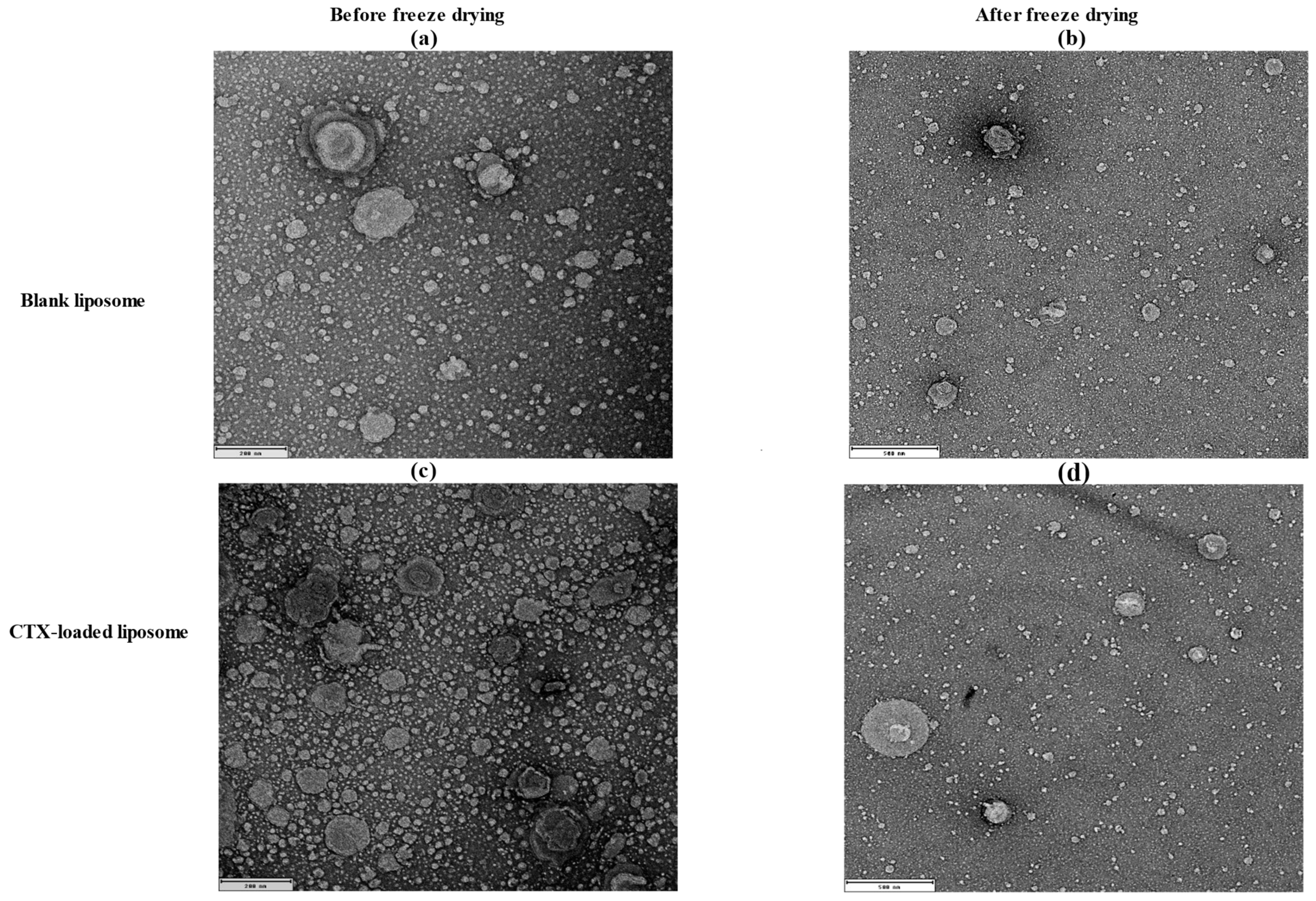

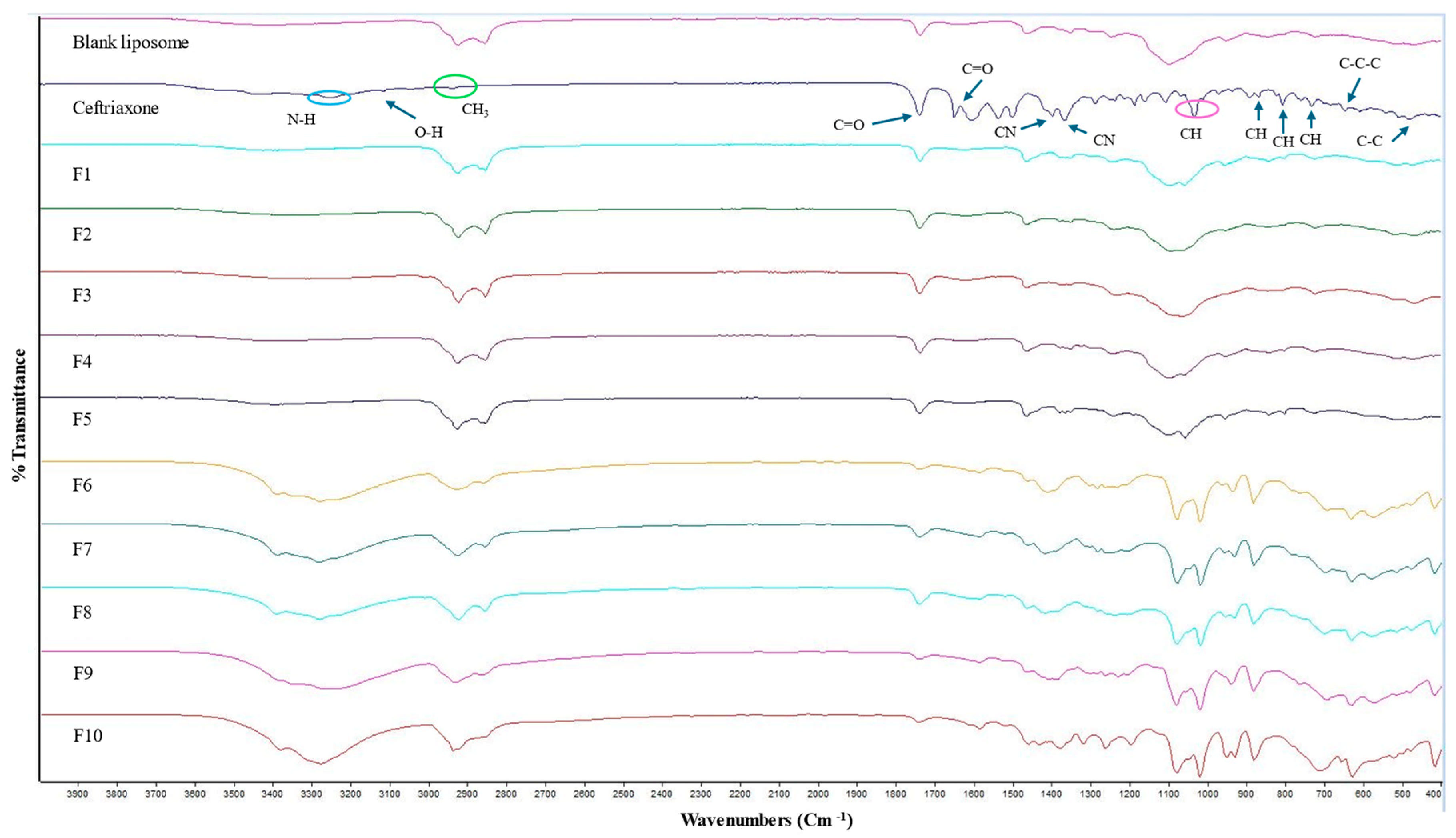
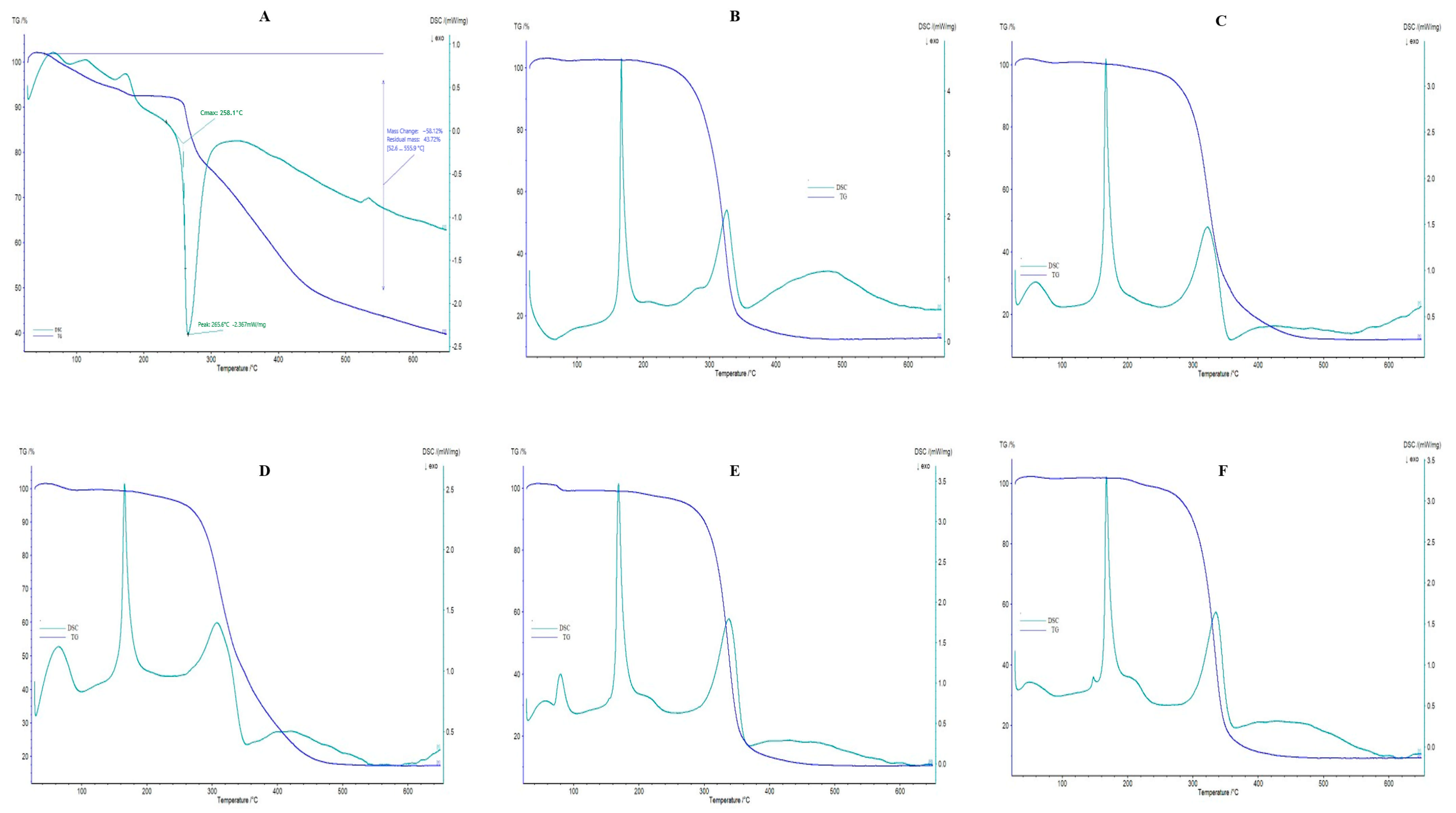
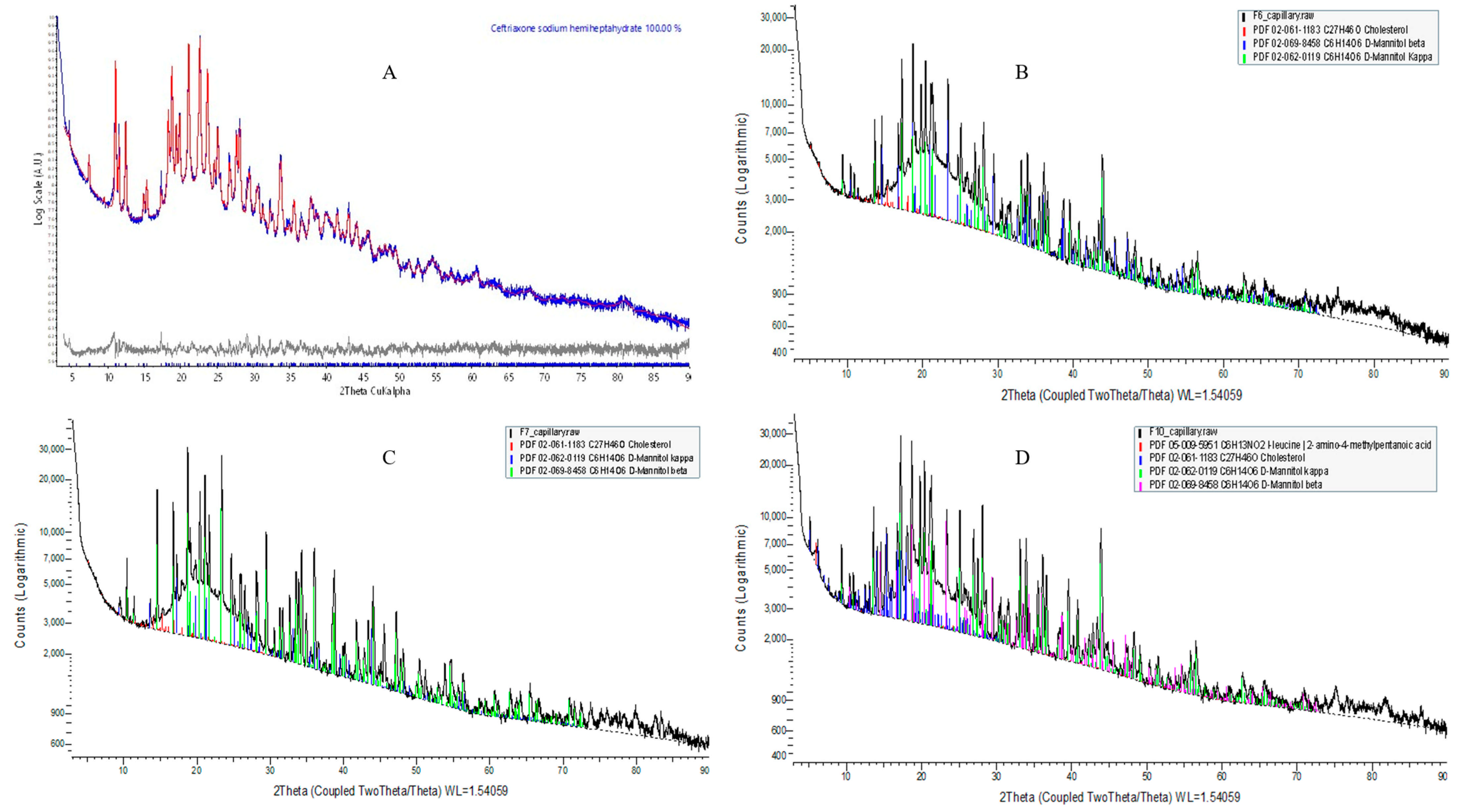
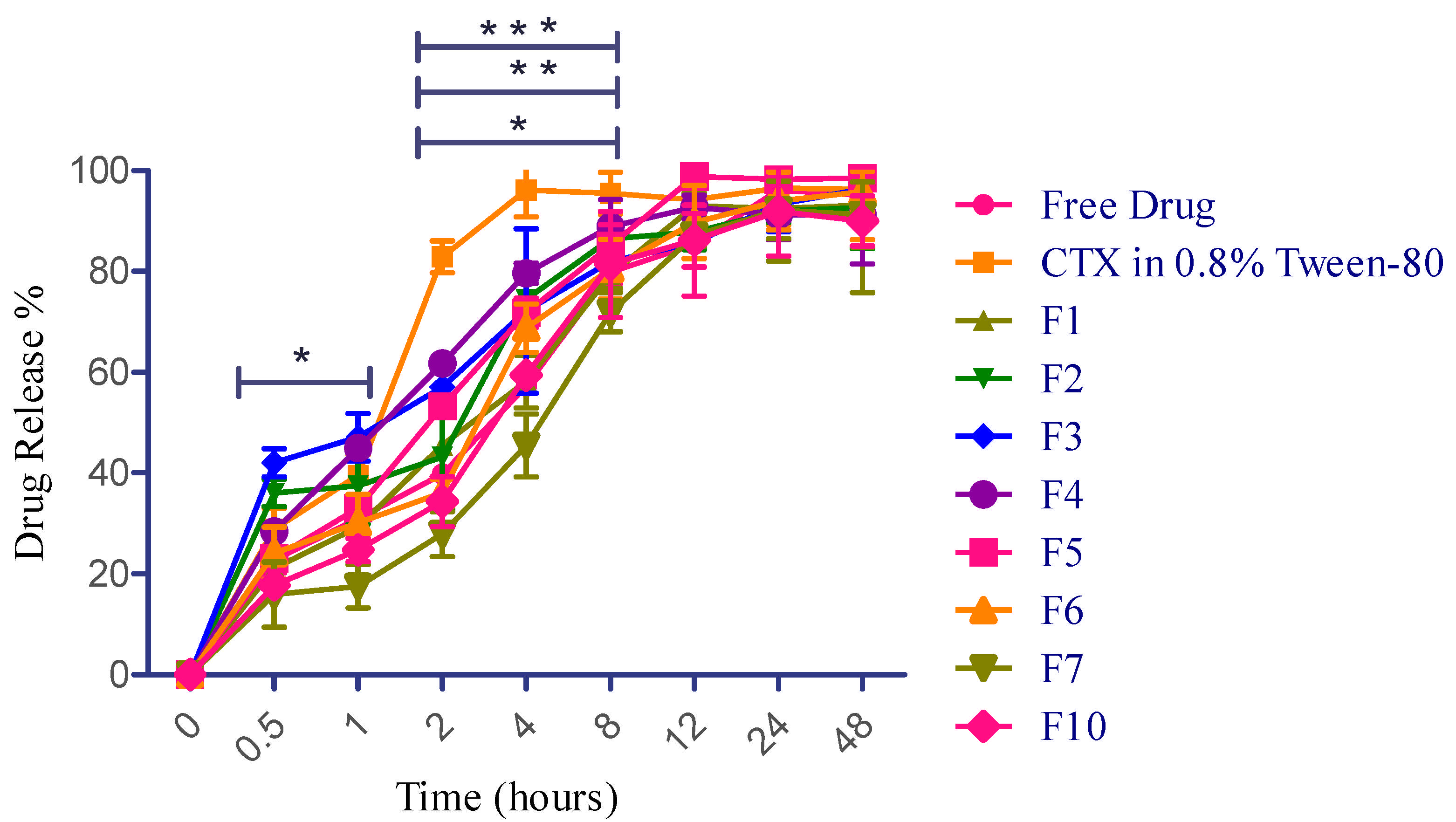
| Change in Phospholipid Concentration | Change in Cholesterol Concentration | D-Mannitol (7.5%) and L-Leucine (1 mL of 5%) | |||||||||
|---|---|---|---|---|---|---|---|---|---|---|---|
| Blank | F1 | F2 | F3 | F4 | F5 | F6 | F7 | F8 | F9 | F10 | |
| Drug and Excipient | Amount (g) | Amount (g) | Amount (g) | Amount (g) | Amount (g) | Amount (g) | Amount (g) | Amount (g) | Amount (g) | Amount (g) | Amount (g) |
| Phosphatidylcholine (L-α) | 0.20 | 0.20 | 0.40 | 0.80 | 0.20 | 0.20 | 0.20 | 0.40 | 0.80 | 0.20 | 0.20 |
| Cholesterol | 0.07 | 0.07 | 0.07 | 0.07 | 0.14 | 0.28 | 0.07 | 0.07 | 0.07 | 0.14 | 0.28 |
| Chloroform | 10.00 | 10.00 | 10.00 | 10.00 | 10.00 | 10.00 | 10.00 | 10.00 | 10.00 | 10.00 | 10.00 |
| Ethanol | 10.00 | 10.00 | 10.00 | 10.00 | 10.00 | 10.00 | 10.00 | 10.00 | 10.00 | 10.00 | 10.00 |
| Ceftriaxone | 0.00 | 0.005 | 0.005 | 0.005 | 0.005 | 0.005 | 0.005 | 0.005 | 0.005 | 0.005 | 0.005 |
| Mannitol | 0.0055 | 0.0055 | 0.0055 | 0.0055 | 0.0055 | 0.0055 | 0.7555 | 0.7555 | 0.7555 | 0.7555 | 0.7555 |
| Tween-80 | 0.25 | 0.25 | 0.25 | 0.25 | 0.25 | 0.25 | - | - | - | - | - |
| L-leucine | - | - | - | - | - | - | 0.05 | 0.05 | 0.05 | 0.05 | 0.05 |
| Deionized water (for hydration with drug and mannitol) | 5.00 | 5.00 | 5.00 | 5.00 | 5.00 | 5.00 | 5.00 | 5.00 | 5.00 | 5.00 | 5.00 |
| Deionized water (for final volume) | 5.00 | 5.00 | 5.00 | 5.00 | 5.00 | 5.00 | 5.00 | 5.00 | 5.00 | 5.00 | 5.00 |
| Total | 30.53 | 30.53 | 30.73 | 31.13 | 30.60 | 30.74 | 31.08 | 31.28 | 31.68 | 31.15 | 31.29 |
| Net weight of liposome (gm) | 10.00 | 10.00 | 10.00 | 10.00 | 10.00 | 10.00 | 10.00 | 10.00 | 10.00 | 10.00 | 10.00 |
| Formulations | Particle Size (nm) | PDI | Zeta Potential (mV) | |||
|---|---|---|---|---|---|---|
| Before Freeze-Drying | After Freeze-Drying | Before Freeze-Drying | After Freeze-Drying | Before Freeze-Drying | After Freeze-Drying | |
| Blank liposome | 169.4 ± 18.0 | 146.1 ± 12.4 | 0.347 ± 0.0 | 0.590 ± 0.0 | −50.1 ± 1.9 | −50.8 ± 1.3 |
| F1 | 286.7 ± 52.6 | 208.4 ± 10.4 | 0.444 ± 0.1 | 0.623 ± 0.0 | −55.2 ± 3.0 | −47.5 ± 1.6 |
| F2 | 90.6 ± 8.1 | 85.2 ± 1.1 | 0.444 ± 0.1 | 0.477 ± 0.0 | −51.6 ± 2.7 | −54.7 ± 0.9 |
| F3 | 93.3 ± 0.4 | 75.6 ± 6.0 | 0.245 ± 0.0 | 0.518 ± 0.0 | −45.8 ± 0.1 | −33.1 ± 7.0 |
| F4 | 428.7 ± 49.0 | 249.5 ± 6.9 | 0.568 ± 0.1 | 0.400 ± 0.1 | −59.5 ± 3.1 | −50.0 ± 2.5 |
| F5 | 501.3 ± 16.1 | 258.8 ± 4.5 | 0.647 ± 0.0 | 0.263 ± 0.0 | −60.9 ± 3.2 | −45.4 ± 0.6 |
| F6 | 173.10 ± 10.7 | 235.73 ± 5.9 | 0.459 ± 0.1 | 0.478 ± 0.0 | −54.87 ± 1.1 | −46.90 ± 0.7 |
| F7 | 144.87 ± 0.8 | 152.53 ± 1.0 | 0.365 ± 0.0 | 0.402 ± 0.0 | −54.13 ± 1.8 | −49.60 ± 0.3 |
| F8 | 124.53 ± 1.6 | 102.30 ± 1.3 | 0.289 ± 0.0 | 0.255 ± 0.0 | −53.40 ± 4.1 | −59.23 ± 0.3 |
| F9 | 290.37 ± 25.0 | 396.97 ± 15.2 | 0.521 ± 0.1 | 0.517 ± 0.1 | −59.57 ± 1.0 | −44.90 ± 1.0 |
| F10 | 413.40 ± 28.5 | 536.90 ± 44.4 | 0.518 ± 0.0 | 0.549 ± 0.0 | −64.43 ± 1.9 | −52.93 ± 7.4 |
| Formulations | Entrapment Efficiency, % | Loading Capacity, % |
|---|---|---|
| Blank liposome | - | - |
| F1 | 4.43 ± 0.4 | 1.54 ± 0.1 |
| F2 | 4.35 ± 0.3 | 1.43 ± 0.1 |
| F3 | 2.42 ± 0.2 | 0.83 ± 0.1 |
| F4 | 6.04 ± 0.7 | 2.00 ± 0.2 |
| F5 | 3.12 ± 0.2 | 1.05 ± 0.1 |
| F6 | 1.70 ± 0.1 | 0.58 ± 0.1 |
| F7 | 1.67 ± 0.4 | 0.50 ± 0.1 |
| F8 | 1.74 ± 0.4 | 0.51 ± 0.1 |
| F9 | 1.45 ± 0.5 | 0.41 ± 0.2 |
| F10 | 1.56 ± 0.2 | 0.40 ± 0.1 |
| Component Phases | Ceftriaxone Sodium Hemiheptahydrate | Cholesterol | D-Mannitol | |
|---|---|---|---|---|
| Chemical Formula | C18H23N8Na2O10.5S3 | C27H46O | C6H14O6 | |
| Space Group | C121 | P1 | P212121 | |
| Lattice | Monoclinic | Triclinic | Orthorhombic | |
| Lattice Parameters | a (Å) | 30.593(3) | 14.165(1) | 8.6792(1) |
| b (Å) | 4.7611(2) | 34.231(5) | 16.9006(1) | |
| c (Å) | 18.587(1) | 10.4699(6) | 5.55051(6) | |
| α (°) | 90 | 94.576(9) | 90 | |
| β (°) | 90.460(5) | 90.578(5) | 90 | |
| γ (°) | 90 | 96.400(8) | 90 | |
| Unit Cell Volume (Å3) | 2707.3(3) | 5027.9(8) | 814.17(2) | |
| Molecule Nos. in Cell Z | 4 | 8 | 4 | |
| Formulations | Zero-Order | First-Order | Higuchi | Hixon–Crowell | Korsmeyer–Peppas | |
|---|---|---|---|---|---|---|
| r2 | r2 | r2 | r2 | r2 | n | |
| Control | 0.8686 | 0.7679 | 0.9817 | 0.9762 | 0.8545 | 0.2756 |
| CTX in 0.8% Tween-80 | 0.8811 | 0.9864 | 0.9574 | 0.9688 | 0.7018 | 0.1947 |
| F1 | 0.8809 | 0.9882 | 0.9935 | 0.9806 | 0.8651 | 0.1838 |
| F2 | 0.8801 | 0.6354 | 0.7084 | 0.9159 | 0.7659 | 0.2004 |
| F3 | 0.6574 | 0.8372 | 0.7247 | 0.8156 | 0.7287 | 0.1765 |
| F4 | 0.7343 | 0.4670 | 0.6246 | 0.8806 | 0.7221 | 0.1788 |
| F5 | 0.8157 | 0.6335 | 0.7396 | 0.9253 | 0.8412 | 0.2383 |
| F6 | 0.8389 | 0.9736 | 0.9660 | 0.9403 | 0.8893 | 0.2606 |
| F7 | 0.9579 | 0.9943 | 0.9879 | 0.9963 | 0.9082 | 0.3301 |
| F10 | 0.8774 | 0.9723 | 0.9804 | 0.9495 | 0.8775 | 0.2782 |
| Parameters | Blank Liposome | F6 | F7 | F8 | F9 | F10 |
|---|---|---|---|---|---|---|
| Bulk density (g/mL) | 0.11 ± 0.00 | 0.13 ± 0.00 | 0.17 ± 0.00 | 0.21 ± 0.01 | 0.11 ± 0.00 | 0.16 ± 0.00 |
| Tapped density (g/mL) | 0.140 ± 0.00 | 0.171 ± 0.00 | 0.219 ± 0.00 | 0.25 ± 0.01 | 0.14 ± 0.00 | 0.21 ± 0.01 |
| CI (%) | 20.03 ± 1.01 | 19.88 ± 1.01 | 22.10 ± 1.20 | 16.25 ± 2.18 | 21.13 ± 2.24 | 20.23 ± 2.53 |
| HR | 1.25 ± 0.01 | 1.24 ± 0.01 | 1.28 ± 0.02 | 1.19 ± 0.03 | 1.26 ± 0.03 | 1.25 ± 0.04 |
| ϑ | 36.49 ± 0.64 | 38.54 ± 2.50 | 41.29 ± 0.59 | 37.93 ± 0.64 | 37.74 ± 2.54 | 37.64 ± 0.67 |
| Formulations | RD (%) | ED (%) | FPF (%) Based on ED | FPF (%) Based on RD | FPD (μg) Based on ED | FPD (μg) Based on RD |
|---|---|---|---|---|---|---|
| F6 | 88.4 ± 4.87 | 59.1 ± 7.3 | 61.46 ± 8.02 | 40.87 ± 4.57 | 56.88 ± 7.42 | 37.83 ± 4.23 |
| F7 | 91.98 ± 3.52 | 69.54 ± 12.05 | 55.73 ± 12.29 | 41.17 ± 6.13 | 43.52 ± 9.60 | 32.15 ± 4.78 |
| F8 | 92.74 ± 3.46 | 66.03 ± 10.62 | 47.17 ± 13.08 | 32.81 ± 7.33 | 28.07 ± 7.78 | 19.53 ± 4.36 |
| F9 | 90.39 ± 1.35 | 61.20 ± 8.08 | 48.15 ± 12.13 | 31.97 ± 6.18 | 41.85 ± 10.55 | 27.78 ± 5.37 |
| F10 | 90.05 ± 6.95 | 67.86 ± 2.44 | 58.72 ± 4.19 | 44.55 ± 5.89 * | 45.51 ± 3.25 | 34.52 ± 4.57 |
Disclaimer/Publisher’s Note: The statements, opinions and data contained in all publications are solely those of the individual author(s) and contributor(s) and not of MDPI and/or the editor(s). MDPI and/or the editor(s) disclaim responsibility for any injury to people or property resulting from any ideas, methods, instructions or products referred to in the content. |
© 2025 by the authors. Licensee MDPI, Basel, Switzerland. This article is an open access article distributed under the terms and conditions of the Creative Commons Attribution (CC BY) license (https://creativecommons.org/licenses/by/4.0/).
Share and Cite
Panthi, V.K.; Fairfull-Smith, K.E.; Wells, T.J.; Wang, T.; Islam, N. Ceftriaxone-Loaded Liposomal Nanoparticles for Pulmonary Delivery Against Lower Respiratory Tract Infections: Development and Characterization. Pharmaceuticals 2025, 18, 414. https://doi.org/10.3390/ph18030414
Panthi VK, Fairfull-Smith KE, Wells TJ, Wang T, Islam N. Ceftriaxone-Loaded Liposomal Nanoparticles for Pulmonary Delivery Against Lower Respiratory Tract Infections: Development and Characterization. Pharmaceuticals. 2025; 18(3):414. https://doi.org/10.3390/ph18030414
Chicago/Turabian StylePanthi, Vijay Kumar, Kathryn E. Fairfull-Smith, Timothy J. Wells, Tony Wang, and Nazrul Islam. 2025. "Ceftriaxone-Loaded Liposomal Nanoparticles for Pulmonary Delivery Against Lower Respiratory Tract Infections: Development and Characterization" Pharmaceuticals 18, no. 3: 414. https://doi.org/10.3390/ph18030414
APA StylePanthi, V. K., Fairfull-Smith, K. E., Wells, T. J., Wang, T., & Islam, N. (2025). Ceftriaxone-Loaded Liposomal Nanoparticles for Pulmonary Delivery Against Lower Respiratory Tract Infections: Development and Characterization. Pharmaceuticals, 18(3), 414. https://doi.org/10.3390/ph18030414







